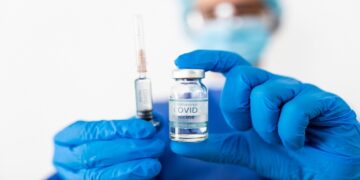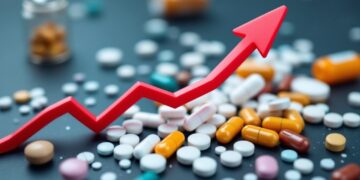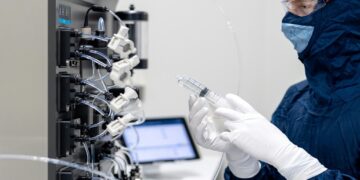Global pharmaceutical corporations have faced extensive scrutiny for various reasons, including inconsistent availability of medications, a lack of transparency in environmental, social, and governance (ESG) practices, and a notable increase in counterfeit drug incidents.
This growing and widespread examination has rendered Industry 3.0, which forms the core of the manufacturing and distribution processes for most pharmaceutical firms today, inadequate.
According to a recent report in the International Journal of Pharmaceutics titled “Industry 4.0 for pharmaceutical manufacturing: Preparing for the smart factories of the future,” pharmaceutical companies must adapt by achieving an unparalleled level of data digitalization. This includes incorporating “supply chain-related data such as raw material variations and global tracking of materials across facilities.”
The reasons for advancing towards more digitally mature pharmaceutical supply chains are multifaceted and extend beyond enhancing supply chain resilience and data-driven decision-making. End-to-end traceability also enhances compliance with existing and forthcoming regulatory standards, aids in achieving ESG objectives, and ultimately safeguards patients.
A Strategic Approach to Fulfilling Regulatory Compliance
Governments and regulatory bodies worldwide are imposing stricter regulations on the pharmaceutical sector to ensure drug safety and quality.
One such example is the Drug Supply Chain Security Act (DSCSA) in the United States, which mandates pharmaceutical businesses to implement a serialized, electronic, and interoperable system for tracking and tracing prescription drugs throughout their supply chain and among all stakeholders. The deadline is approaching rapidly: November 27, 2023.
Yet, the DSCSA represents just the beginning. The following is an up-to-date breakdown of how various countries and government agencies are adopting more stringent regulations, compelling pharmaceutical companies to digitalize their supply chains for improved traceability.
Supply chain digital maturity is no longer an optional feature; it has become the new frontier in pharmaceuticals to mitigate mounting risks for companies in this field.
Other organizations, including GS1, which oversees several traceability standards in healthcare, the World Economic Forum (WEF), and the World Health Organization (WHO), are also offering guidance on developing best practices for traceability in the healthcare sector as a whole.
Compliance with these regulations will become indispensable to avoid costly penalties and legal actions, which can erode trust among healthcare providers, patients, watchdog groups, the media, financial institutions, and investors.
Reducing the Incidence of Counterfeit Products and Theft in Pharmaceutical Supply Chains
The World Health Organization (WHO) estimates that approximately 11% of medications in developing countries are either substandard or falsified, with many low- and middle-income nations bearing the economic burden of counterfeit drugs.
Ongoing research by the Pharmaceutical Security Institute raises a similar alarm. In 2021, there were 5,987 incidents of pharmaceutical crimes, a 38% increase from 2020. These incidents affected 142 countries across all seven regions of the world, with North America and the Asia Pacific leading in numbers. Experts estimate that the global counterfeit pharmaceutical market is valued between US$200 and US$432 billion.
Moreover, the problem of counterfeit drugs extends beyond shady illegal street markets. According to the National Association of Boards of Pharmacy, “Even identifying a legitimate online pharmacy that sells U.S. FDA-approved medicines to U.S. consumers is challenging, given that there are 35,000 active online pharmacies in operation today, and 96% of them violate applicable laws.”
Industry experts and government bodies once again recommend real-time traceability solutions that enable pharmaceutical companies to receive immediate notifications of nonconformities and counterfeiting alerts. This allows for faster and more efficient recalls, thereby safeguarding patients.
Rising Expectations for ESG and Transparency
Regrettably, due to a history of greenwashing and consumer perceptions of a lack of transparency, the pharmaceutical industry has not been seen as a leader in the fight against climate change and social injustices.
As stated in a Pharmaceutical Technology article, Lotfi Belkhir, an associate professor of engineering at McMaster University and chair of eco-entrepreneurship, noted, “The pharmaceutical industry seems to have hidden behind its image of clean factories producing life-saving drugs. Who cares about the carbon footprint when you’re doing so much for humanity, right?”
Nevertheless, according to research from 2019, large pharmaceutical companies were found to be more carbon-intensive and generated 55% more emissions than the automotive industry, partly due to the need for cold storage.
Despite the inherent complexity of their supply chains, pharmaceutical businesses are taking concrete steps to meet ESG targets, whether by participating in the Pharmaceutical Supply Chain Initiative, obtaining EcoVadis ratings, or monitoring Scope 1, 2, and 3 emissions.
Nevertheless, regardless of the actions taken, supply chain traceability can serve as evidence that sustainability standards are being met at every stage. Without this level of transparency, companies will struggle to determine the true impact they are making.



















